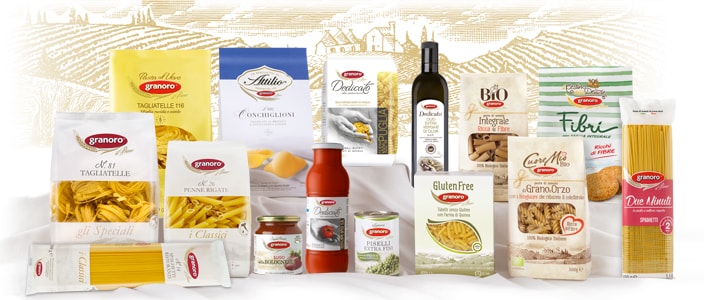-
Recognising good quality pasta is simple! Just rely on the following sensory criteria that are simple to identify when assessing the raw product:- appearance: the pasta should be evenly smooth, golden yellow in colour and you should not be able to see any lines, dots or dark areas when you look through it;- when cooking, the cooking water should be as clear as possible, with little or no residues: this means that the pasta does not release any starch or other substances into the cooking water, retaining all of its nutritional value;- smell: it should not have any particular odour;- taste: raw pasta should have a slightly sweetish note;- sound: raw pasta should make a snapping sound when broken;- touch: the break should be smooth and vitreous.
-
The main difference is in the treatment of the finished product for the purposes of conservation and durability: dried pasta is subject to a drying process, which reduces the degree of humidity by up to 12.5%;fresh pasta can be sold as it is after extrusion. It must be kept refrigerated (from 2°C to 4°C) to prevent alteration. If fresh pasta is to be packaged, it must have a minimum humidity content of 24% and be pasteurised.Dried pasta may only be produced and sold in Italy if it is produced using dough made from durum wheat flour (semolina, semi-whole wheat semolina and whole wheat semolina). In addition to durum wheat flour, soft wheat flour can also be used to make fresh pasta.
-
Durum wheat and soft wheat mainly differ in what is produced by the milling process, which is performed using different technologies.Durum wheat is harder (more vitreous) than soft wheat. They therefore have a different appearance and colour after milling: semolina is an amber yellow colour and has grains with sharp edges (like sugar). Flour varies in colour from white to pale hazelnut, has rounded grains and is soft to the touch (like talcum powder).On average, durum wheat has a higher protein content than soft wheat.
-
Italian pasta production must comply with the Italian law concerning the purity of pasta: Law 580 dated 4 July 1967 and subsequent amendments (in particular, the Decree of the President of the Republic 187 dated 9 February 2001).This regulation specifies that pasta must be produced exclusively using products obtained from durum wheat (semolina, semi-whole wheat semolina and whole wheat semolina).
-
Because it is good-quality pasta!Durum wheat semolina is selected according to strict criteria; the production process uses technology that does not alter the characteristics of the semolina; our personnel are attentive and well qualified; constant quality controls are performed throughout the entire production process.
-
The semolina used to make GRANORO pasta is purchased from local mills and is produced from high-quality durum wheat grown in Italy, Canada, USA, Australia, France, Greece and Spain.Granoro pasta is an Italian pasta and Italian pasta is the best in the world, thanks to a production culture based on the careful selection of raw materials (in accordance with their cooking properties) and consistent product quality. Granoro skilfully blends high-quality semolina from durum wheat grown in Italy and other parts of the world to extract the very best characteristics from all of them and create excellent pasta.
-
No. Canada, USA, France and Australia – to name just a few – use advanced agricultural techniques and crop rotation, selecting varieties based on precise criteria subject to continuous agronomic assessment and boast internationally renowned research organisations. These countries produce high-quality durum wheat, equal to those produced in some regions of Italy.It is well known that as far back as 1826, Russia was considered the wheat belt of the world alongside Italy. It was famous for the durum wheat variety TANGAROG (now extinct), which was considered the best for producing pasta thanks to its high percentage of protein, in particular gluten.Its quality does not depend on where it is grown, but on a series of clearly identified parameters shared by agronomic science all over the world.
-
Genetically modified durum wheat does not exist and Granoro is against the use of any type of GMO in its products.
-
The production process for durum wheat semolina pasta can be divided into the following steps:- Blending- Mixing- Kneading- Extrusion- Drying- Cooling- Packaging
-
Blending is the stage during which various types of durum wheat semolinas, selected and distinguished by their high-quality characteristics, are blended together according to the type of pasta shape required.
-
Semolina and water are combined in the feeder and the dough is mixed in a stainless steel vessel. Traditional technology uses two blade shafts to work the dough, pushing it towards the extruder screw.For Granoro, the mixing stage is of fundamental importance: it is during this stage that the starch and protein bind with the water and start to form gluten, a protein mesh that traps within its links the starch granules hydrated with water from the mixture, binding them together.
-
Starch is a complex sugar that is very important to our organism, especially for the correct functioning of our body’s muscles, including the brain.Starch is a carbohydrate found in 60-70% of the wheat grain and contained in raw pasta in the form of granules.Gluten traps the starch in its mesh, keeping it within the pasta and preventing it from being lost in the cooking water.
-
Gluten is a viscous substance, a type of glue produced during hydration by the interaction of two proteins, gliadins and glutenins.Gluten forms a more or less uniform and regular mesh between the starch granules, trapping them there.
-
Kneading is the process designed to make the dough smooth and compact. It is performed in the mixer.With reference to semolina, grain size means the diameter of the semolina particles; it has a direct impact on the composition of the dough.Granoro pasta uses semolina with a large grain size, which results in increased production time and costs, but protects the structure of the durum wheat from damage caused by milling. Not by chance, large-grain semolina is known as “sublime semolina” in the industry.
-
Extrusion is the process during which the dough is forced through an extrusion die.The extrusion die is a tool of cylindrical or rectangular parallelepipedal shape with inlet and outlet holes on the upper and lower faces respectively. This tool gives the dough the plastic shape of the pasta shape required (tubular for spaghetti or bucatini, or concave or spiral for short pasta).The extruding part of the hole may be made of bronze (an alloy of copper with another metal) or Teflon (a plastic material smooth to the touch).Bronze extrusion is gentler than Teflon extrusion as it produces a certain degree of attrition when the dough is extruded, and therefore heat, which can damage and “burn” the protein content of the durum wheat semolina. Pasta made with a bronze extrusion die has a porous, rough and matt surface. Teflon dies, smoother and more polished, reduce attrition to a minimum, releasing less heat. This produces a pasta with more strength, an intense flavour and a bright colour.The choice of extrusion die (bronze or Teflon) is based on the type of pasta shape required, which is why here at Granoro we use both Teflon and bronze dies.
-
GRANORO pasta is available in more than 150 shapes suitable for all types of recipes and are divided into the following ranges: standard pasta shapes, special semolina pasta, egg pasta, spinach pasta, special “Sfoglia Antica”, Specialità di Attilio, burnt wheat pasta, organic pasta, Dedicato range and finally the Cuore Mio range, functional pasta, rich in fibre and Beta-glucan, made with durum wheat semolina and barley flour.
-
To assess the nutritional value of pasta, you must always take into account what ingredients will be served with it. A portion of pasta without any sauce has an intake of about 350 kcal, a value that rises depending on the type of condiment added, which completes the nutritional value. A plate of spaghetti served with a tuna and tomato sauce provides about 630 kcal (more than a quarter of the average person’s recommended daily calorie intake). The 350 kcal provided by the pasta without sauce are composed of complex carbohydrates (72-70%), protein (of which gluten is the most important) at the rate of 10-13% and a trace amount of fats.Pasta also has a low glycemic index.In the Mediterranean diet, pasta is the perfect vehicle for introducing other ingredients needed to create a complete and healthy meal.
-
The high quality of pasta depends on its protein content, in particular gluten, and its starch content. These substances constitute the structure of the pasta and affect the transformations that occur during cooking, determining the quality of the end result. They are also the nutritional elements by which it is distinguished and must therefore remain intact, even once it has been cooked.
-
During cooking, gluten and starch behave in opposite ways: starch absorbs water and swells up until it breaks, releasing its contents into the water, whereas gluten protein forms a compact mesh designed to trap as much starch as possible.These transformations occur almost simultaneously, at the same temperature, and it is therefore inevitable that there is some competition between the starch, which tends to absorb the water, swelling up until it bursts, and the protein mesh, which tends to prevent the release of starch.
-
Pasta is not good quality if starch wins the competition and dissolves completely, resulting in sticky, limp pasta and cloudy, white cooking water at the end of the cooking process. Good quality pasta is one in which the gluten manages to prevent the starch from absorbing too much water, protecting the inner substance with clear benefits in terms of the flavour of the pasta and its consistency.
-
The idea that pasta is fattening is a common misconception. Just think that 100 g of plain pasta only contains 350 calories and it is a filling dish. The calorie intake is practically equal to a soft drink or two glasses of wine, which are much less healthy. Just think that a 100 g bar of chocolate provides the body with 400 calories and a traditional piadina filled with tomato, mozzarella and Parma ham provides on average about 540 calories.
-
Good quality pasta, especially once cooked, should be a bright golden yellow, the same colour as durum wheat.In relation to the presence of white dots, they may be caused by:- grains in the semolina that have lost their vitreous nature and are therefore more difficult to hydrate;- dough not hydrated evenly; - the decision to use large-grain semolina, as is the case with Granoro. On the one hand, this choice makes it harder to hydrate the semolina granules evenly, thus creating white dots, whilst on the other hand it limits damage to the starch granules and ensures optimum gluten development.Remember, gluten is the most important protein contained in durum wheat semolina pasta. From both a nutritional and sensory point of view, the elasticity and toughness of pasta during mastication (that al dente sensation, when pasta is firm to the bite) depends on the quality and quantity of gluten.
-
Recognising good quality pasta is simple! Just rely on the following sensory criteria that are simple to identify when assessing the raw product:- appearance: the pasta should be evenly smooth, golden yellow in colour and you should not be able to see any lines, dots or dark areas when you look through it;- when cooking, the cooking water should be as clear as possible, with little or no residues: this means that the pasta does not release any starch or other substances into the cooking water, retaining all of its nutritional value;- smell: it should not have any particular odour;- taste: raw pasta should have a slightly sweetish note;- sound: raw pasta should make a snapping sound when broken;- touch: the break should be smooth and vitreous.When the product has been cooked:- appearance: the pasta should be bright golden yellow in colour;- once drained, it should be well separated and not coated in a starchy film;- it should be cooked evenly, inside and out, without any raw parts;- it should have an intense aroma of durum wheat semolina;- when tasted, it should have a slightly sweet aftertaste typical of good quality semolina;- on mastication, it should be elastic and strong;- when drained and served on a plate, dressed with just a dash of oil, it should not clump together and should remain as if just drained, even after many hours.We like to summarise all of these qualities in one image:Excellent pasta should “sing on the plate”, even many hours after cooking.

 Italiano
Italiano
 English
English
 Français
Français
 Deutsch
Deutsch
 Español
Español
 Português
Português
 Japanese
Japanese
 русский
русский

 中國
中國




